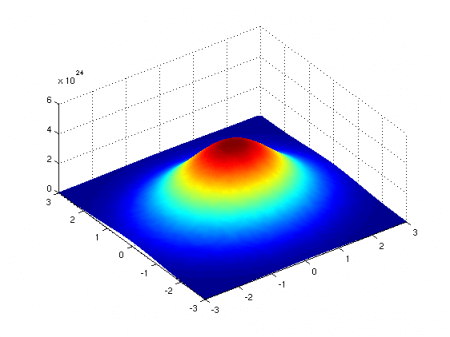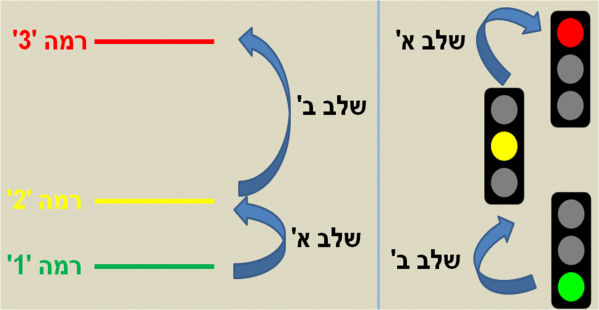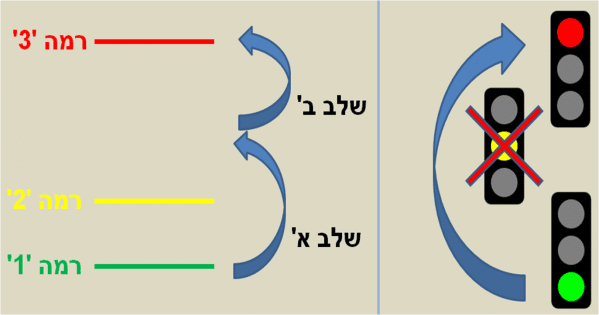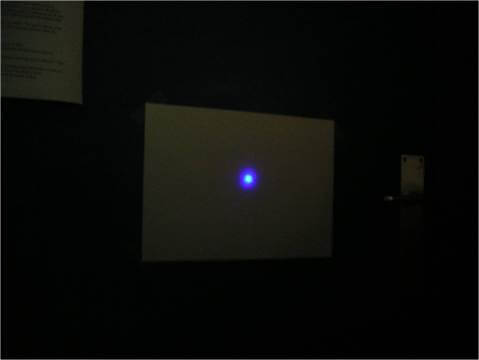I met with Gil Porat to ask him what is being done there at the university.

I met with Gil Porat to ask him what is being done there at the university.
Gil is a PhD student in electrical engineering. He carries out his research work in Prof. Adi Arie's laboratory for nonlinear optics at Tel Aviv University. He lives in Tel Aviv with his wife who is also working on her doctoral thesis in the field of computer science. Gil is very fond of science fiction, and in the past was involved in organizing conferences on the subject.
Gil, so what are you doing there?
Our laboratory deals with various fields of optics, namely the study of light and the interaction of light and matter, and especially in the field called 'non-linear optics'.
What is nonlinear optics? How is it different from normal optics?
Everyone knows that matter affects light, for example the reflection of light from a mirror, the refraction of light rays upon entering water or the concentration of light rays after passing through a lens. What not everyone knows is that light can affect a material and change its properties. For example, if we shine a very strong and concentrated light on a crystal, for example with the help of a laser, the way in which that crystal affects the light passing through it will change. That is, a situation is created in which the light indirectly affects itself.
Can you give an example of such a process?
Yes, there is, for example, an effect called self focusing. Projecting a powerful laser beam on a material causes the refractive index of the material to change. The stronger the power, the greater the refractive index. Suppose we project a beam onto the material in which the light intensity is strong in the center and weakens on the sides (see Figure 1). The refractive index of the material will change according to the division of light, i.e. high in the center and weak on the sides. This causes the material to act like a lens and concentrate the light beam that we sent and which originally caused the change.
It is also worth mentioning that it is possible to get a color change, for example you can project a laser beam on a crystal in the infrared range and get a green laser beam at the output (frequency doubling). And it is also possible to sum colors (=frequencies), i.e. project two laser beams at certain frequencies and receive at the output a beam with a frequency that is the sum of the input frequencies.
Why do all these non-linear effects occur?
Light entering a transparent material can be thought of as pleasant elevator music that excites the electrons. The music is moderate and the electrons move to its beat. This dance causes the emission of light radiation at the frequency of the incoming light. On the other hand, projecting a very strong light into the material can be imagined as loud and loud music to the point that it causes the electrons to lose rhythm and crackle in a tumultuous dance mixing different rhythms. These electrons will emit light with different properties than the one that entered.
Does it work for any material?
 No, it depends on several factors. Some of the phenomena (such as self-focusing) can in principle occur in any transparent material, but a particularly high light intensity is required in order to observe them. Another part of the phenomena can exist only in crystals with suitable structural properties.
No, it depends on several factors. Some of the phenomena (such as self-focusing) can in principle occur in any transparent material, but a particularly high light intensity is required in order to observe them. Another part of the phenomena can exist only in crystals with suitable structural properties.
In any case, when it comes to a color change, usually no light of the new color will be received at the output. The reason for this is that the 'new' light waves, which arise in different areas of the crystal, are not synchronized with each other. As a result, a cyclic process occurs where light enters the crystal, some 'new' light is produced, and then the 'new' light is converted back to the 'old' light. In certain crystals, this phenomenon can be overcome with the help of a careful design of the crystal that will cause synchronization, so that the intensity of the 'new' light will increase along the path of its progress through the crystal (for those interested in going deeper: Quasi-phase-matching).
What are you working on in the field?
One of the projects I worked on is the demonstration of a known quantum effect using nonlinear optics. The source of inspiration for the project came from Dr. Haim Suchovski who showed that it is possible to take a known effect from atomic physics and apply it with the help of lasers and non-linear optics.
What is the connection between all these things?

In all these atomic systems the electrons can only have certain energy values, meaning that the allowed energy levels are discrete. When it comes to crystal lasers, there are only certain colors that can be obtained as a result of a non-linear process. That is, the allowed colors are discrete.
What is the quantum effect that you wanted to realize with the help of non-linear optics?
We will focus on three of those discrete levels. An electron that is in the lower level can be raised to the upper level in two steps: providing energy suitable for moving it from level 1 to level 2, then providing energy suitable for moving it from level 2 to level 3 (see Figure 2). It should be noted that since only these three levels are possible, then providing an inappropriate amount of energy will not allow the electron to pass between the levels. Also, since the electron 'aims' to be in the lowest possible level, we will need to perform the second step before it spontaneously returns from level 2 to level 1.
If we imagine a traffic light where the green light turns on when there is an electron in level 1, the yellow light for an electron in level 2 and the red light for an electron in level 3, the traffic light will start green, move to yellow and end in red (see Figure 2).
Now, what do you think will happen if first we give the electron too much energy for the transition from 1 to 2, and then, we give it too little energy for the transition from 2 to 3, but we make sure that the sum of the energies we put in corresponds to the difference between level 1 and -3 (see figure 3)?
Intuition tells me that since the first crossing cannot take place, then the light at the traffic light will remain green.
So let's put intuition aside. What will really happen is that the electron will reach level three without being at level 2. That is, the traffic light will start green and go directly to red without yellow, and this despite the transition being made in two stages, apparently by transitioning into a forbidden energy state.
Ok, very strange, and how did you implement the effect using non-linear optics?
Basically we replaced the energy levels from the quantum pattern with the colors of lasers. We project a laser beam into the crystal that is analogous to a level 1 electron, then sum it twice with other laser beams, similar to adding energy to an electron to move it to a higher level.
We designed the crystal so that the intermediate operations of the frequency scheme will not be effective, and therefore we will not receive the intermediate frequency of the connection at the output. But we did receive the frequency of the total amount at the exit. That is, similar to the quantum example, we climbed to the top of the ladder without stepping on the steps in the middle. In practice, we inserted a mid-infrared laser (wavelength 3 µm) into the system and received at the exit only a blue laser beam (452 nm), which is the result of connecting the frequencies (see photo).
Thus we showed that this idea can be applied in an optical experiment. Also, beyond the basic science, we also have some ideas for interesting uses, but that's a topic for another conversation.

I would be happy to meet and talk with any research student (maybe you?) who is willing to participate and tell me a little about what he is doing (and all for the price of a not too long conversation). You can contact me through the contact form.
It's time to tell everyone what you're doing, maybe this time they'll understand too

25 תגובות
I'm just doing a project on a part of the topic, with the simple examples you gave helped us a lot!
Thanks 🙂
anyway,
https://www.hayadan.org.il/free-speach-20100800/comment-page-35/#comment-351874
Thank you Ehud. Indeed, it is light from the pulse itself that goes back and reaches the camera.
age,
I hope you are not embarrassed by the comments of one of the commenters here. He is known for his condescending attitude and attitude towards others who have studied and know no less than him (I am not talking about myself).
Sorry again, and thank you.
Israel,
I have no knowledge on the subject, but from a physical point of view, you don't actually photograph pulses of light, but rather light
From the pulse itself that goes back and reaches the camera. On the site you linked the camera speed is
One divided by ten to the 12th power of the second, but with computational means they manage to reproduce pulses
which are a thousand times faster than the speed of photography.
Regarding your link, I thought to Tommy that the speed of the camera is determined by its electronics
And I assumed that we were talking about a collection of capacitors from a ccd camera, but it turns out that this is a different technique
reader,
I'm not familiar with the phenomenon of problems in the field of mathematics, I've been able to reveal a lot
Troubles in the field of physics where everyone, regardless of their education, has the theory
his big It's just a shame that no one on the site has already found a cure for cancer...
Probably in biology hassle is less common.
Ehud, does it bother you?
I have already read messages here from geniuses who dismiss all modern physics on the grounds that it "doesn't add up in their heads", and are trying to create a new physics that will explain the phenomena at the forefront of science. And based on what? Probably nothing. They have no formal education.
In the end, this is just another facet of the phenomenon of hassles that is so well known on the Internet in the field of mathematics.
A question for Gil or Ehud or anyone who knows.
As far as I know, it is possible to photograph pulses of light in motion. for example:
http://web.media.mit.edu/~raskar/trillionfps/
Do you know the technical details, for example what is the minimum frequency of the stills camera? How can I conduct such an experiment myself? Where can I get equipment? costs? For example, is it possible to download an app for the iPad? Is there any parallel through which a similar experiment can be conducted but with radio waves instead of light?
I know that photographs of pulses of light passing through milky water were taken already 40 years ago by mechanical means only.
Thanks.
age,
I see that you are not offended by the initial reaction you received
"Gil Porat
So, first of all: "photons..." yes "...interact with each other directly."
And so there is actually no point in the discussion.
I was disturbed by the attitude and attitude expressed in the response. A physics doctoral student has been studying for years
Many and deals in a certain field about which he is interviewed.
Suddenly something emerges whose entire education amounts to reading a site or two on Wikipedia and appeals
On his words and further states emphatically that the doctoral student is wrong. I can't stand the attitude
Anyone who has read a popular science book considers himself an expert in his own right. I guess
Because that commenter's emphatic assertion
"So, first of all: "photons..." yes "...interact with each other directly."
She came because he didn't read the article and didn't understand that you were being interviewed in it, he is simple
Thought he was correcting another responder but even in this case a little modesty is needed
If you do not understand a certain area, do not comment on it decisively. In the end
I see that this commenter realized that he was wrong and decided to mend his ways in this case
And I hope for the next one as well and that he has learned a lesson although I am satisfied and therefore again
Thank you for the explanations and your willingness to be interviewed and explain your research.
Gil Porat,
I apologize for the comments of whoever dragged you to this telenovela. And I want to thank you for your explanations, and for investing your time in referring to the responses to the article.
I'm glad you recognized the dilemma of semantics, as it appears in the various responses.
Of course, it is important to clarify that the sentence -
"The probability that two photons will collide is extremely small, usually they will just pass each other. In the event that they collide, there will of course be a conservation of momentum and energy" - from the link I provided in my response earlier, explains my intention nicely in the sentence: "Photons..." yes "...interact with each other directly."
Of course, those (and again I thank you for noticing) who do not pay attention to semantics, can make a mistake and write a sentence like: "Two photons cannot collide..." which is presented here:
https://www.hayadan.org.il/dont-stop-at-yellow-230712/comment-page-1/#comment-351876
And therefore it is important to clarify that, as you understood, the photons can indeed collide - but with a low probability.
But the use and enjoyment of language and concepts is also required of those who are not only learning but also of those (or who think they are...) who are teaching others.
Thanks.
age,
It is important to clarify again to the readers that photons cannot interact with each other.
Since photons are quanta of the electromagnetic field and do not carry a charge they cannot
interact. Photons interact with electrically charged particles.
Regarding entangled particles there is no interaction between them. Use interaction to
Interweave particles but after that it is not possible to speak in the language of the particles but in the language of the situation
Heshar, I suppose that what I write is not clear to those who have not studied a course or two
In quantum theory, but I also assume that you agree with the above assertions.
What are the correlations between entangled particles? It is not a matter of energy or momentum transfer but rather
Purely in correlations. For example, as soon as the momentum of one particle is measured, the momentum of
The second slide was determined before it had no value whatsoever. The naive form is not
Correctly assumes that as soon as the momentum of one particle is determined, it transfers from the momentum
of the second particle so that the total momentum is conserved. This can be proven experimentally with
A pair of EPR particles that are one outside the light cone of the other and therefore
A measurement to one cannot transfer momentum or energy to the other particle. in my opinion
Anyone who does not understand this does not understand quantum theory.
I would love to hear if you disagree with the claims I presented.
Just to clarify the misunderstanding in the responses I will quote one of the first responses
which is in the wrong passage and I quote:
"Gil Porat
So, first of all: "photons..." yes "...interact with each other directly."
R. H. Refai.M and Ehud
I think the explanation in the link that appears in the last message of R. H. Refai.m is good, and as far as I can see it corresponds to what Ehud wrote.
I think there is a misunderstanding between you that stems from different definitions for the same concepts. I'm sorry but I'm having a hard time untangling and finding exactly where the lack of coordination between you is, especially when we communicate via text (and translating concepts into Hebrew adds more ambiguity).
Good,
I give up,
Maybe this will explain to laymen:
http://davidson.weizmann.ac.il/online/askexpert/physics%5C%D7%9E%D7%94%20%D7%A7%D7%95%D7%A8%D7%94%20%D7%9C%D7%90%D7%A0%D7%A8%D7%92%D7%99%D7%94%20%D7%9C%D7%AA%D7%A0%D7%A2%20%D7%95%D7%9C%D7%A9%D7%93%D7%94%20%D7%94%D7%90%D7%9C%D7%A7%D7%98%D7%A8%D7%95%D7%9E%D7%92%D7%A0%D7%98%D7%99%20%D7%A9%D7%9C%20%D7%A4%D7%95%D7%98%D7%95%D7%9F%20%D7%9B%D7%90%D7%A9%D7%A8%20%D7%94%D7%95%D7%90%20%D7%9E%D7%AA%D7%A0%D7%92%D7%A9%20%D7%A2%D7%9D%20%D7%A4%D7%95%D7%98%D7%95%D7%9F%20%D7%90%D7%97%D7%A8%3F%20%D7%90%D7%99%D7%9C%D7%95%D7%9F
age,
I hope you haven't gone to sleep yet and had time to read Ehud's response. And if yes, then it is important to clarify:
that the correlations are not measured with a laser device through a "defron" browser. It is important to emphasize this.
The correlations are the 'definitions that are read', in the notebook, of physical values that are actually measured as a way of interaction between particles, and which is (in this case) the conservation of momentum and energy of the particles.
age,
By the way how about the following explanation explaining why two photons cannot interact.
There are 4 forces in nature through which elementary particles interact. the relevant force
Photons that have no gravitational mass have the electromagnetic force. The electromagnetic force
It is a force between a field and a charge, since a photon has no charge, an electromagnetic force cannot act on it.
The same argument also explains that it is not possible to change the path of a light beam by means of a magnetic field.
Do you have another simpler explanation why two photons cannot interact
Not through matter?
age,
I think the matter has not been clarified enough. Two photons cannot collide or
to interact not through matter for example energy transitions in atoms
or through the creation of a particle-antiparticle pair from the vacuum.
Interweaving is not interaction as anyone who has studied a bit of physics knows.
Shazira talks about correlations between measurements, not about the transfer of momentum and energy
between separate particles. If it is possible to talk about separate particles, this is not the case
In interlacing and if it is an interlaced situation, it is not possible to talk about the interaction
Between particles the descriptions are as if complementary.
I gave up trying to explain the issue, maybe you do
You will do better than me.
R. H Rafai M
I study at Tel Aviv University, I didn't notice the mistake.
Also, I thanked Ehud for the comments. I understand that you study at the Weizmann Institute, and not Tel Aviv, as it says?
A final explanation for laymen,
It is important not to confuse semantics with definitions of physical values.
Gil Porat,
Don't get me wrong, scientists like you are at the forefront of Israeli science. And thanks to you, science in the State of Israel is - as it is. I appreciate you for that.
Thank you for the reference to the Wikipedia entry. My desire was to sharpen the understanding of the readers who do not understand what it is about and I hope I succeeded in doing so.
What I wanted to emphasize was the semantic difference in your words. which, as you wrote:
"I will only write that photon entanglement is done by interacting with matter."
And "I didn't draw a parallel between matter and a photon. I wrote that a photon interacts with matter.”
It would be appropriate if you write down 'photon' - that you write down 'electron' (and not 'matter'). Even though there could have been a different 'matter-particle'.
And regarding the entanglement, I just wanted to point out that two photons can indeed collide and can indeed make a 'direct connection' or 'interaction' (as you wrote). And I based myself on the logical semantics in your words and that's why I wrote: that the laws of conservation of momentum and energy are the 'interaction' or 'direct connection' between photons (which can indeed collide, albeit with a low probability).
Thank you for your attention.
R.H. Rafai.M
I think there is a misunderstanding here about the concept of "interaction". Phenomena related to interference are not considered interaction (no creation or destruction of photons, no exchange of energy between different modes of oscillation of fields). I don't want to go into details about quantum entanglement. I will only write that photon entanglement is done by interacting with matter. Details can be read here:
http://he.wikipedia.org/wiki/%D7%A9%D7%96%D7%99%D7%A8%D7%94_%D7%A7%D7%95%D7%95%D7%A0%D7%98%D7%99%D7%AA
I did not make a comparison between matter and photon. I wrote that a photon interacts with matter. Different photons interacting with the same material affect the material and are affected by it directly, so indirectly they affect each other.
sympathetic
Thanks for the comments.
Sometimes it is necessary to specify precisely for those of little faith and unfortunately I do not like to quote
From Wikipedia because much of the knowledge there is superficial but sometimes there is no choice.
About Two-photon physics it says:
"From quantum electrodynamics it can be found that photons cannot couple directly to each other"
Conclusion When someone is doing a doctorate at the Weizmann Institute like Gil, it is advisable to respect his knowledge especially in his field
he deals
It is also important to understand the difference between interaction and correlations. And the educated at that time will stand still.
It is also important to mention to the laymen (so that there are no confusions):
During a quantum arena, the photons actually have a direct relationship between them, which is the conservation of momentum and energy.
And it's important to clarify:
that the photon interacts - not with matter - but with an electron and other photons and a few more...
age,
Thank you for taking the trouble to tell about your university research. Of course photons do not interact
Everyone knows this, in addition, it is important to explain to laymen the difference between quantum entanglement and interaction
Because you can get confused between them.
As a curiosity by the way, it seems to me that photons can interact not only through real matter but also through vacuum
through the process of creating a virtual electron-positron pair.
Gil Porat
So, first of all: "photons..." yes "...interact with each other directly."
Read (one example) here:
https://www.hayadan.org.il/fat-photon-in-weizmann-1605102/
"Photons interact with matter, which functions as a sort of intermediary between them." - The comparison between matter and photon in this context is not accurate. And in my opinion even wrong.
First of all, it is important to understand that photons do not interact with each other directly. Photons interact with matter, which acts as a kind of mediator between them.
Non-linear effects with discrete photons have indeed been demonstrated experimentally. Usually the mediating material is a thin gas with properties suitable for a certain effect.
Will we observe in some laboratory in the world a non-linear effect between discrete photons?